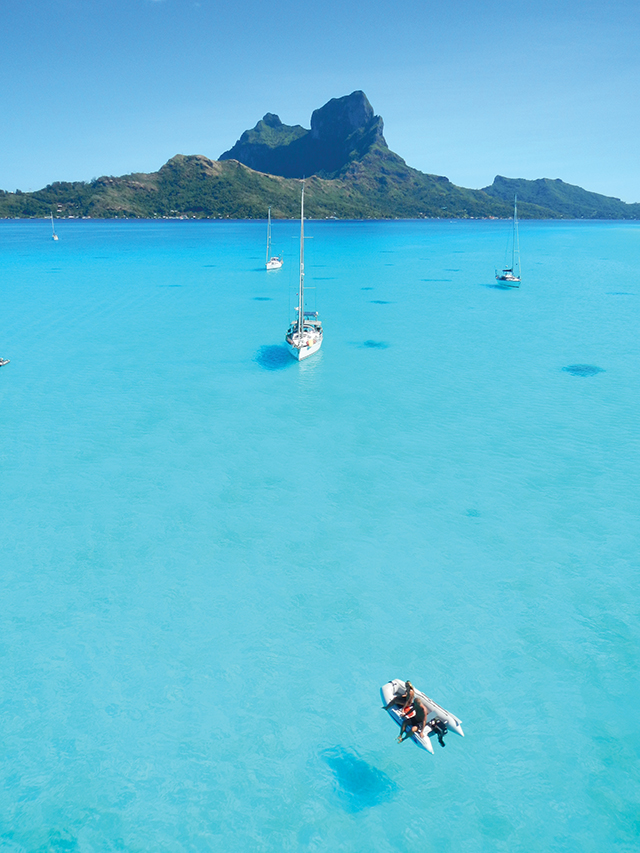A cruiser’s guide to one of the South Pacific’s most dreamy destinations (published April 2014)
You know you’ve been spoiled by the South Pacific when you have to drag your protesting child off to snorkel with “just another” manta ray or when you find that Bora Bora just isn’t satisfying enough. Your floating home rests on one beautiful, placid lagoon after another with the sound of distant waves on the reef soothing you like a lullaby each night. If this isn’t the good life, what is?
So where exactly does one find this paradise? Before visiting the South Pacific on our 1981 Dufour 35, Namani, I have to admit to having had rather vague notions of what constituted the Society Islands. Tahiti and Bora Bora were on my radar, but the true gems, —places like Maupiti—I had never even heard of. The following is a cruiser’s primer to this collection of islands that are the destination of many sailors’ dreams.
Captain Cook named the Society Islands in honor of the Royal Society, a scientific body spearheading the Age of Enlightenment in 18th century England.
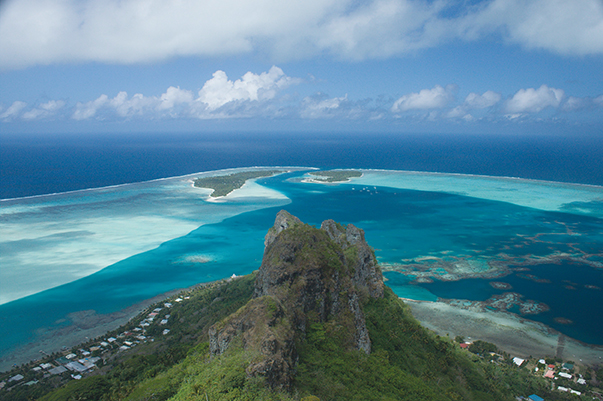 Tahiti is just one island, the administrative capital and gateway to the rest of the Society Islands. The archipelago is made up of two loose clusters: Tahiti and Moorea lie at the eastern, or windward, edge of the group, appearing as two towering beauties separated by a mere 20 miles. From there, it’s a good 90 miles to the nearest island of the leeward group, made up of Huahine, Raiatea and Tahaa (two islands that share one lagoon), and Bora Bora. At the far westernmost end of the chain are the quiet and often overlooked Maupiti and Maupelia. All are lush, green islands with stunning volcanic silhouettes, except for the black sheep of the family, Maupelia, a low-lying atoll in this otherwise lofty group.
Tahiti is just one island, the administrative capital and gateway to the rest of the Society Islands. The archipelago is made up of two loose clusters: Tahiti and Moorea lie at the eastern, or windward, edge of the group, appearing as two towering beauties separated by a mere 20 miles. From there, it’s a good 90 miles to the nearest island of the leeward group, made up of Huahine, Raiatea and Tahaa (two islands that share one lagoon), and Bora Bora. At the far westernmost end of the chain are the quiet and often overlooked Maupiti and Maupelia. All are lush, green islands with stunning volcanic silhouettes, except for the black sheep of the family, Maupelia, a low-lying atoll in this otherwise lofty group.
But alas, the pleasures of this island group are fleeting for anyone crossing the Pacific in a single season. Compounding the sheer distances between ports of call is the fact that North Americans are entitled to a mere three months in all of French Polynesia—from the wild Marquesas to the atolls of the Tuamotus and the jaw-dropping landscapes of the Society Islands. That leaves the average cruiser with about a month to whirl through the Societies. Given a finite amount of time, how does a sailor whittle down the possible choices to the very best of the best? If we had to name our top picks in the Society Islands, the Oscars would go to…
GREAT ANCHORAGES
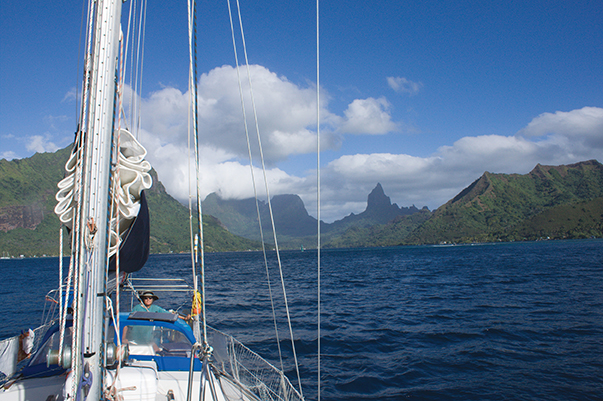 For panoramic photos of your boat in the foreground of a stunning Society Island’s landscape, nothing beats the sheer, chiseled heights of Moorea’s Opunohu Bay. You can anchor on either side of the entrance or at the head of the bay, where the holding is generally secure. (That’s a good thing, since gusts can funnel wildly down the steep valley.) After the photo shoot, you can dinghy ashore for fresh baguettes or play hermit in your own little corner of paradise.
For panoramic photos of your boat in the foreground of a stunning Society Island’s landscape, nothing beats the sheer, chiseled heights of Moorea’s Opunohu Bay. You can anchor on either side of the entrance or at the head of the bay, where the holding is generally secure. (That’s a good thing, since gusts can funnel wildly down the steep valley.) After the photo shoot, you can dinghy ashore for fresh baguettes or play hermit in your own little corner of paradise.
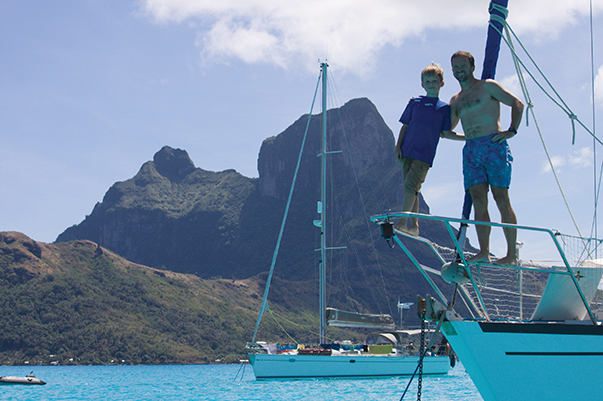 Having almost written off Bora Bora as spoiled by over-development, we had to revise our verdict after a blissful week in the southwest corner of the lagoon . The gorgeous, sandy anchorage quickly won us over with its peaceful aura, the views of Bora Bora’s iconic central peak and its excellent snorkeling (see below). Getting there means circling Bora Bora in a clockwise direction and slaloming through a narrow, snaking pass through an inner reef in the northwest corner of the lagoon. It’s a nail-biter, but the pass is marked and depths are at least nine feet.
Having almost written off Bora Bora as spoiled by over-development, we had to revise our verdict after a blissful week in the southwest corner of the lagoon . The gorgeous, sandy anchorage quickly won us over with its peaceful aura, the views of Bora Bora’s iconic central peak and its excellent snorkeling (see below). Getting there means circling Bora Bora in a clockwise direction and slaloming through a narrow, snaking pass through an inner reef in the northwest corner of the lagoon. It’s a nail-biter, but the pass is marked and depths are at least nine feet.
Avea Bay on the southwest corner of Huahine draws cruisers more because of its serenity than its dramatic beauty. There’s plenty of space for boats to spread out, each with their own swath of views to the distant reef and Raiatea on the horizon. You can snorkel, take walks ashore, or feast on a traditional earth-oven roast offered by a low-key resort. Reaching Avea Bay via the narrow, sheltered lagoon is a scenic cruise in itself, with gorgeous views opening to the island’s interior. The lagoon channel is buoyed all the way to Avea, with minimum depths of eight to 10 feet.
You’ll find gorgeously isolated anchorages at many of the “motus” (islets) within the shared lagoon of Raiatea and Tahaa. Tiptoe up to the inner edge of the reef and anchor on a sandy bottom and you’ll feel like you’re at the edge of the universe. Some spots are shallow while others deep, but they all resonate with the quiet roar of ocean swell pounding the outer reef. Raiatea’s Motu Tipemauo (off Iriru Pass) and Tahaa’s Motu Mahaea (off Toahotu Pass) are only two magnificent, solitary examples among many.
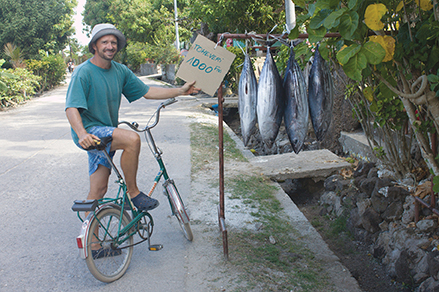 The gem of them all, however, is sleepy little Maupiti , located 25 miles downwind of Bora Bora. In fact, it’s a miniature Bora Bora, with the same stunning aquamarine coral ring surrounding a tall central peak. Maupiti sees very little tourism and there is only one small village and no visible hotels marring the lagoon. Boats can anchor just inside the pass near a spot frequented by manta rays, or just off the village for walks ashore (both detailed below). The only trick is getting in (and out), since the narrow pass can be potentially dangerous in a sizable south or southwest swell. In any other conditions, range markers make running the pass a breeze.
The gem of them all, however, is sleepy little Maupiti , located 25 miles downwind of Bora Bora. In fact, it’s a miniature Bora Bora, with the same stunning aquamarine coral ring surrounding a tall central peak. Maupiti sees very little tourism and there is only one small village and no visible hotels marring the lagoon. Boats can anchor just inside the pass near a spot frequented by manta rays, or just off the village for walks ashore (both detailed below). The only trick is getting in (and out), since the narrow pass can be potentially dangerous in a sizable south or southwest swell. In any other conditions, range markers make running the pass a breeze.
GREAT HIKES
Cruisers based in Moorea’s Opunohu Bay can dinghy to the head of the bay and hitchhike up to the Belvedere (a view point) to reach the trailhead for the Three Coconut Trees Pass. This moderate walk leads through beautiful wooded stretches and eventually gains views high over both Opunohu and Cook Bays (one hour each way starting from the Belvedere). On the way back, reward yourself with a delicious pineapple ice cream at the Agricultural College, two-thirds of the way up the valley road.
For eagle eye views over breathtaking aquamarine lagoons and the deep blue horizon, scale the central summits of Maupiti or Bora Bora. Maupiti’s Tiriano peak is a 1,000-foot uphill trek that is manageable in under an hour. The very last section requires scaling steep rocks, but a sturdy rope will see you safely to the top. Scaling Bora Bora’s Otemanu peak, on the other hand, is a serious endeavor at twice the Tiriano trek’s vertical distance. Steep sections are not for the faint of heart and the trail calls for serious footwear.
GREAT SIGHTS AND EXPERIENCES
The annual Heiva festival on Tahiti is one of the true highlights of the Pacific cruising season (every July in and around Papeete. Events range from hula-style dance competitions to traditional sports such as gaily-colored fruit basket races. Tickets are available at the Carrefour supermarket box office (see BWS June 2013 issue for details).
Paul Gauguin lived in Tahiti before moving on to greener pastures in the Marquesas and the site of his home is now an interesting museum. A visit there makes for a perfect day out by rental car and can be combined with hikes and views of waterfalls on the leeward shore of Tahiti. While you have a car, take a driving adventure through waterfall-lined Papenoo Valley in the island’s interior (two-wheel-drive vehicles suffice).
Bicycling any of the quieter islands can provide a great change of pace for any sailor. Many islands have ring roads that run along the lagoons that are more or less flat. Great destinations for a ride are the southern half of Huahine, any shore of Moorea or Bora Bora and the six manageable miles around little Maupiti. The roads are generally in good condition, navigation is easy and vehicle rentals are available in most cases.
GREAT SNORKELING
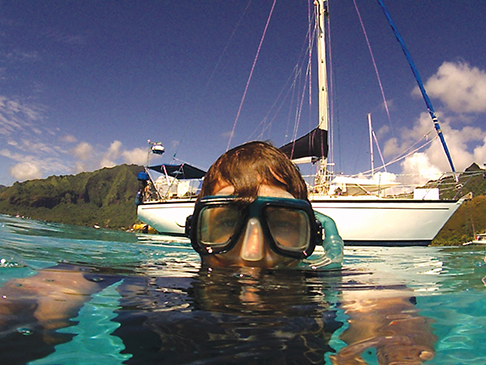 Tahaa’s coral gardens truly are an underwater marvel. Snorkel the shallow slot between two small “motus” on the west side of Tahaa, where fish swim through narrow, canyon-like passages between walls of tightly packed coral. Leave your dinghy on the east side of the “motu” and wear sandals for the walk to the west side, then float back through the coral gardens. Sunset views from this anchorage are nothing short of spectacular, with the profile of Bora Bora punctuating the western horizon.
Tahaa’s coral gardens truly are an underwater marvel. Snorkel the shallow slot between two small “motus” on the west side of Tahaa, where fish swim through narrow, canyon-like passages between walls of tightly packed coral. Leave your dinghy on the east side of the “motu” and wear sandals for the walk to the west side, then float back through the coral gardens. Sunset views from this anchorage are nothing short of spectacular, with the profile of Bora Bora punctuating the western horizon.
Sadly, much of Bora Bora’s reef has fallen to storm and human damage, but a few captivating spots still remain. The southwest corner of the lagoon has some poor reefs, but it also has some spectacular ones with coral of all shapes and sizes hosting a good variety of tropical fish. If you’re lucky, you might even catch a glimpse of the granddaddy of all eels—the moray. Anchor your dinghy carefully in a remote spot far from the beach hotel of Motu Piti Uu Tai for the best spots.
Snorkeling or diving among resident manta ray populations is an incredible experience. One community frequents a spot near Bora Bora’s Hotel Meridien, on the east side of the lagoon. Look for the patch of deep water midway between the outer motus and the “mainland”. Another population can be found at the anchorage just inside Maupiti’s pass. Both of these places are deep and neither is crystal-clear, but the excursion is well worth the effort—particularly if you find a cleaning station, which is a sort of manta ray wellness spa where tiny fish fuss over the mantas’ sleek tuxedo coats.
OFF THE BEATEN TRACK
Maupiti, a gorgeous little island lost in time, is the insider’s pick of the Society Islands. Both cycling around Maupiti and scaling its peak make our short list of absolute highlights in the entire Pacific. Good quality drinking water is available from public taps scattered along the island’s ring road, and three tiny shops offer the basics. Fishermen sell the catch of the day at the roadside, which is your best bet for a tasty tuna dinner.
Unlike its cousins to the east, Maupelia (also spelled “Mopelia”) is a low-lying atoll. This is the least frequented of the Society Islands with navigable passes, since the pass is so narrow. Even some seasoned cruisers describe the narrow slot as terrifying. Good conditions are a must. Those who do visit report memorable snorkeling, diving and island hospitality.
PRACTICALITIES
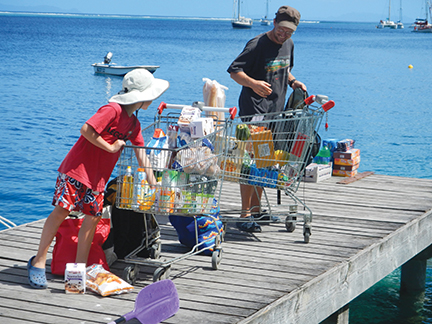 French and Tahitian are the two languages of these islands. Though the islanders are well accustomed to tourists, they usually take the time for a friendly exchange. Try greeting people with a friendly “iorana” instead of “bonjour.” ATMs are few and far between, so be sure to stock up on CFPs (Cour de Franc Pacifique, a currency tied to the Euro) before heading away from Tahiti’s Papeete or Bora Bora’s Vaitape.
French and Tahitian are the two languages of these islands. Though the islanders are well accustomed to tourists, they usually take the time for a friendly exchange. Try greeting people with a friendly “iorana” instead of “bonjour.” ATMs are few and far between, so be sure to stock up on CFPs (Cour de Franc Pacifique, a currency tied to the Euro) before heading away from Tahiti’s Papeete or Bora Bora’s Vaitape.
Your best bet for provisioning outside the massive “hypermarchés” of Tahiti (chain stores such as Carrefour and Champeon in Papeete and near Marina Taina) is the large supermarket in Huahine’s main town, Fare. There, you can anchor in deep water (25 to 30 feet) and dinghy in or tie up alongside the small dock for a short stop. While one crewmember tops up the water tank for a small fee, another can go shopping just a few hundred yards down the road. Even Bora Bora’s shops are not as well stocked as this one. Eggs are a rarity throughout all the islands, so grab several dozen when you get the chance!
Tahiti itself has lost a lot of the magic that once so captivated sailors, including the mutineers of the Bounty. On the other hand, Papeete is the best place for spares, repairs and general supplies between Panama and New Zealand. We found that prices were comparable with those we later saw in New Zealand and were glad not to have put off the new standing rigging that our boat so sorely needed. Tahiti and Raiatea both offer several options for haul outs. Cruisers who must leave their boats unattended for visits to home can consider Tahiti’s Marina Taina (for moorings or berths; reservations for peak season are recommended) or the public quay in Papeete. In past years, stories of rats and theft marred the reputation of the public docks but we heard only satisfied reports during our visit.
Bora Bora is the last place to purchase duty-free fuel before heading west to the Cook Islands or Samoa, but you’ll only be granted this privilege if you obtained a tax-free form back in Papeete. Plan ahead or you’ll pay full price.
ONWARD, EVER ONWARD
Months of superlative scenery and experiences in French Polynesia spoiled us rotten, so these tips are truly the best of our best. Ultimately, even Bora Bora redeemed itself, in spite of the shore-stealing hotels that had initially turned us off. The kids, of course, complained about months of being dragged out on one stunning, unforgettable excursion after another, but we reckon someday they’ll appreciate what we’ve given them. We adults, on the other hand, didn’t suffer from delayed gratification. The Societies were grand in every sense of the word. But time was short, and the siren song of other South Pacific destinations eventually lured us away. We packed our boat with supplies and memories, and like Captain Cook, “directed our course to the West and took our final leave of these happy isles and the good People in them.”
Nadine Slavinski is the author of the book Lesson Plans Ahoy: Hands-On Learning for Sailing Children and Home Schooling Sailors. Currently on sabbatical from teaching, she cruises aboard her 35-foot sloop, Namani, with her husband and young son. After a season in the southwest Pacific, Namani is cruising eastern Australia. Slavinski’s websites, www.nslavinski.com and www.sailkidsed.net, list free resources for home schooling sailors.

















